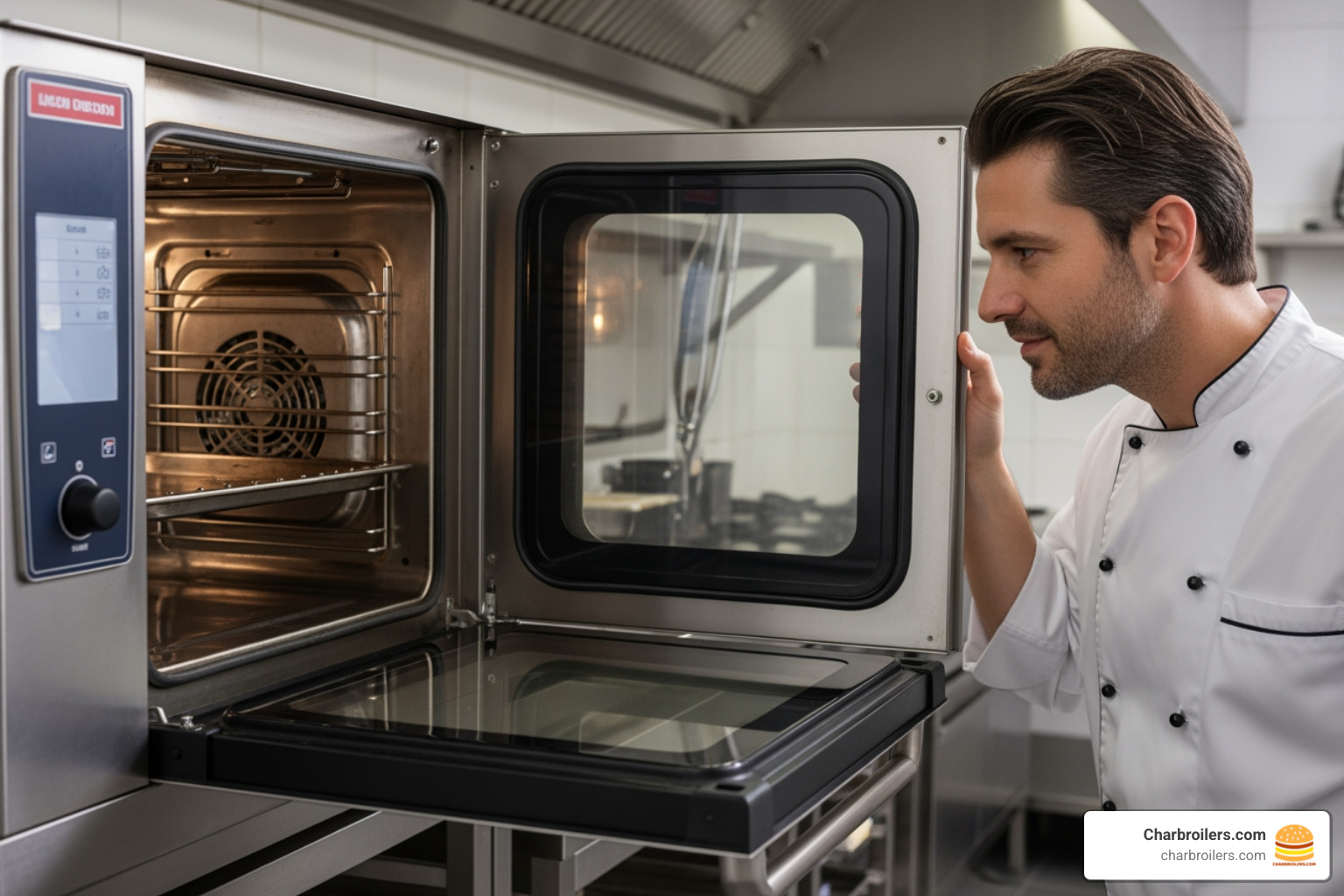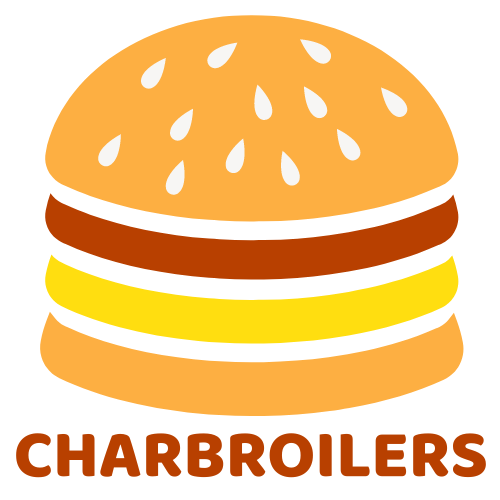
Don't Ruin Your Oven: Safe Cleaning for Self-Cleaning Convection Ovens
Share
Why Cleaning Your Self-Cleaning Oven the Wrong Way Can Cost You Thousands
What is a safe commercial cleaner for self-cleaning convection oven? The safest approach is to avoid chemical commercial cleaners entirely. Instead, use:
- For manual cleaning: A paste of baking soda and water, followed by a vinegar rinse
- For automated systems: Only the manufacturer-specified detergent designed for your specific oven model
- For deep cleaning: The oven's built-in self-clean cycle (pyrolytic or steam)
- Never use: Standard commercial oven cleaners containing sodium hydroxide or other harsh chemicals—they will damage the oven's interior coating and void your warranty
Self-cleaning convection ovens save hours of labor, but using the wrong cleaner can permanently damage the specialized interior coating, leading to costly repairs or replacement.
While nearly 90% of modern ovens have self-cleaning features, manufacturers universally warn against using chemical cleaners. These products cause etching and discoloration of the porous enamel liner, which can impair heating, increase energy use, and cause the self-clean function to fail.
This guide will walk you through how to clean your self-cleaning convection oven safely, protecting your investment while maintaining food quality and kitchen safety.
I'm Sean Kearney from Charbroilers.com. With over a decade in the restaurant equipment industry, I've seen operators make costly cleaning mistakes. This guide will help you avoid them and keep your oven running at peak performance.
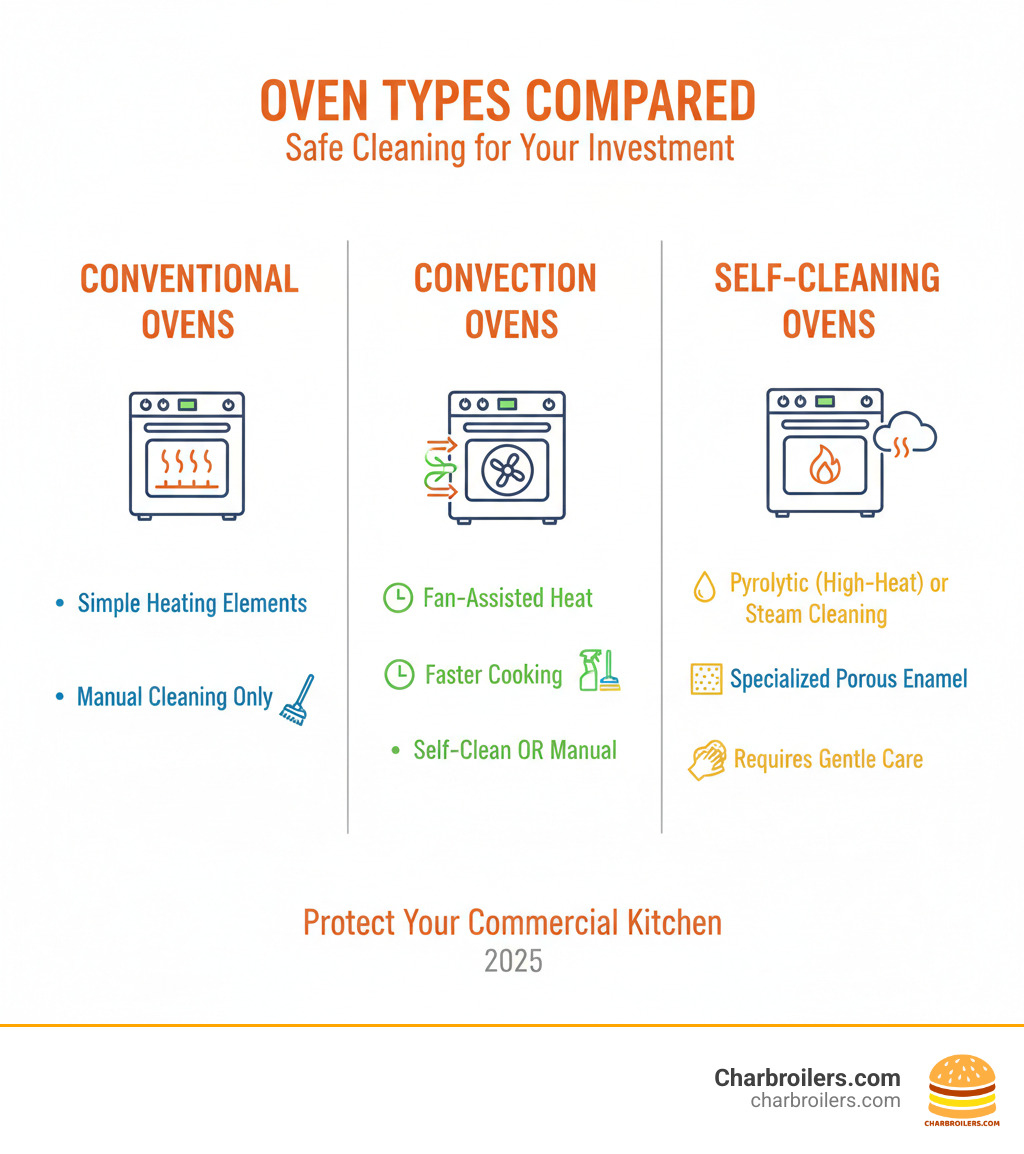
What is a safe commercial cleaner for self-cleaning convection oven terms to know:
- convection oven cleaning tips
- convection oven safety tips
- how does a commercial convection oven work
Why Your Self-Cleaning Convection Oven Needs Special Care
Unlike conventional ovens, convection ovens use a powerful fan to circulate hot air throughout the cooking chamber. This fan-assisted heat distribution eliminates hot spots and reduces cooking times, boosting kitchen efficiency.
Nearly 9 out of 10 modern commercial ranges now include self-cleaning functions. These automated cycles save significant labor hours and maintain oven performance for years.

Most self-cleaning ovens use one of two methods. Pyrolytic cleaning uses extreme heat (around 800°F or higher) to incinerate food and grease into a fine ash that you can wipe away. Steam cleaning is a gentler alternative that uses lower temperatures and moisture to loosen lighter spills.
Here's the critical part: the interior of these ovens is coated with a special porous enamel lining. This sensitive coating makes self-cleaning possible, but it cannot withstand the harsh chemicals found in standard oven cleaners. Commercial kitchens produce heavy grease and grime, making the self-cleaning function invaluable—but it also makes understanding what is a safe commercial cleaner for self-cleaning convection oven equipment absolutely essential.
The high heat of a pyrolytic cycle puts stress on oven components, and you may notice some normal discoloration over time. You must also plan for smoke and fumes during the cleaning cycle. Proper ventilation is non-negotiable. Turn on your kitchen's exhaust hood and ensure staff stay clear of the area. For more detailed safety protocols, see our guide on following convection oven safety guidelines.
Your self-cleaning convection oven is a sophisticated tool. The specialized coating requires special care, which is why understanding safe cleaning methods is crucial for protecting your investment.
The Hidden Dangers: Why Standard Commercial Cleaners Are a "No-Go"
It's tempting to use a heavy-duty oven cleaner on baked-on grease, but this is a costly mistake for self-cleaning ovens. Using standard commercial cleaners is one of the worst things you can do, and it's the core of understanding what is a safe commercial cleaner for self-cleaning convection oven.
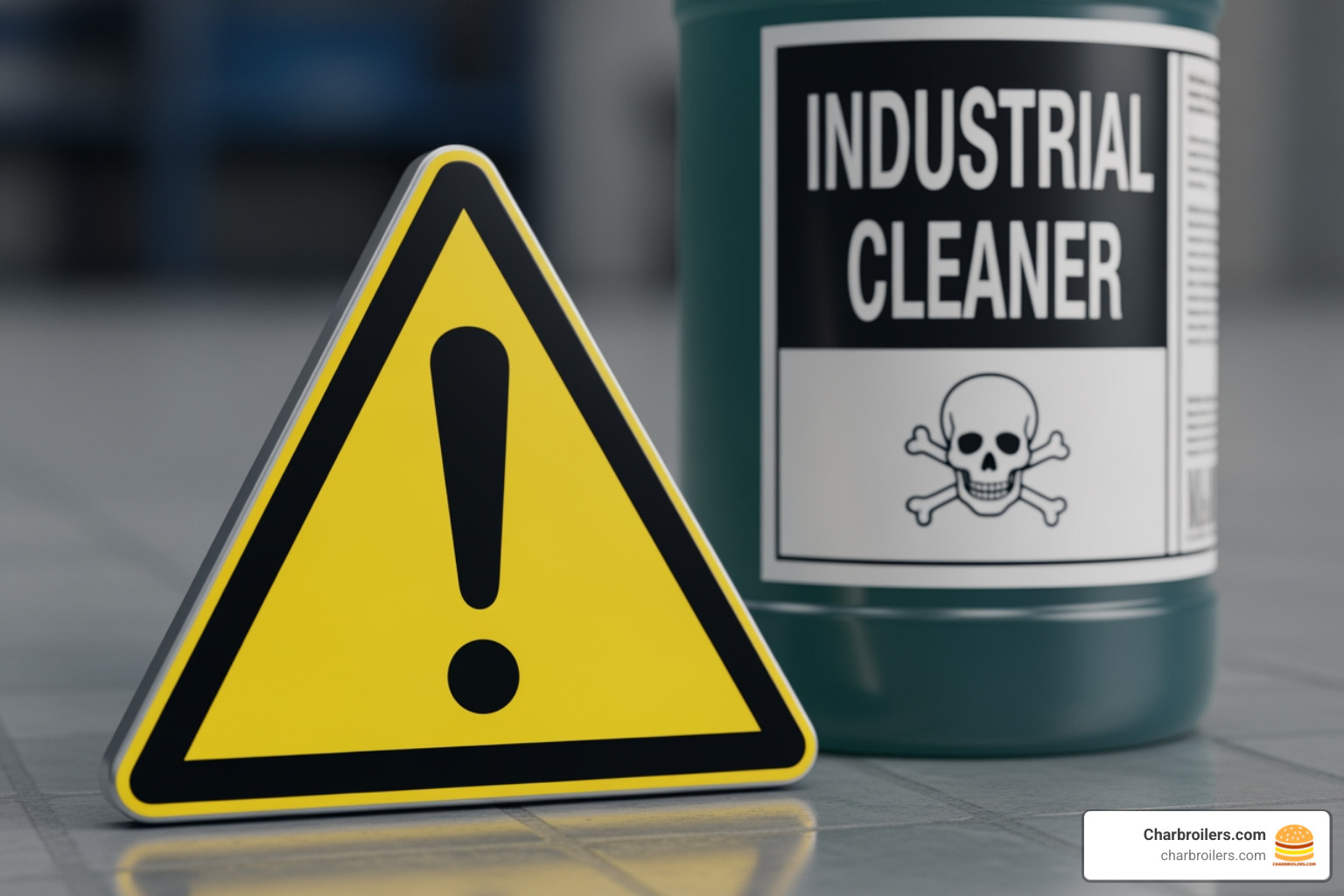
Standard commercial oven cleaners contain corrosive chemicals like sodium hydroxide (lye) and butoxydiglycol. While effective on some surfaces, they are harmful to your oven's specialized liner and your staff.
When these harsh chemicals meet the delicate porous enamel, they begin to eat away at it. This causes etching (pitting the surface) and discoloration. More importantly, it compromises the liner, preventing the self-clean cycle from working correctly. The oven can no longer reach the proper temperatures or release burnt-on food residue as ash. You're left with an expensive oven that can't clean itself.
Crucially, manufacturers will void your warranty if you use chemical cleaners. GE Appliances states, "Do not clean your Self-Clean oven with commercial oven cleaners, even those specifically designed for use with Self-Clean ovens." Continuous use causes permanent damage. A voided warranty means you're responsible for repairs or a premature replacement of equipment that should have lasted over a decade.
These chemicals also pose a serious risk to your team. Sodium hydroxide can cause severe skin and eye burns, and the fumes are hazardous in poorly ventilated kitchens. There are safer alternatives that don't put your staff or your equipment at risk.
The first rule for what is a safe commercial cleaner for self-cleaning convection oven is to keep standard chemical cleaners far away from your equipment.
What is a Safe Commercial Cleaner for a Self-Cleaning Convection Oven?
The short answer: It depends entirely on your oven's specific cleaning system.
Using the right cleaner is like using the right fuel for an engine. The integrated cleaning system dictates what is a safe commercial cleaner for self-cleaning convection oven setups.
For Automated Cleaning Systems
Many advanced commercial ovens have automated cleaning programs that require specific, manufacturer-approved detergents. These systems precisely dose and circulate a cleaning solution that is formulated to be effective yet safe for the oven's internal components, seals, and coatings. Brands like Unox, Ovention, and Convotherm offer their own branded solutions.
Rule #1: Only use the detergent specified by your oven's manufacturer. Using any other chemical will likely damage the oven and void your warranty. Check your manual.
What is a safe commercial cleaner for a self-cleaning convection oven for manual cleaning?
For spot treatments and general manual cleaning, the safest options are non-chemical and non-abrasive. The best cleaner may already be in your pantry.
Our top recommendation is a simple paste of baking soda and water. Mix about half a cup of baking soda with a few tablespoons of water to create a thick paste. Apply it to soiled interior surfaces (avoiding heating elements and the fan), let it sit for several hours or overnight, then wipe it out. For stubborn spots, a spray of white vinegar will create a fizzing action to help loosen residue before you wipe again.
For exterior surfaces and general wipe-downs, a gentle, pH-neutral dish soap and water solution is safe. Avoid abrasive pads like steel wool on the oven's interior liner, as they will scratch the delicate enamel. And, of course, never use harsh chemicals containing sodium hydroxide. For more tips, see our Convection Oven Cleaning Hacks.
Assessing Your Cleaning Needs
Knowing when to clean is key to your oven's efficiency and longevity. Perform daily wipe-downs of spills with a damp cloth and dish soap to prevent buildup. A weekly cleaning can address minor splashes.
It's time for a deep clean or to run the self-clean cycle when you notice:
- Lingering odors that carry over between dishes.
- Visible smoke during preheating, indicating heavy, baked-on grease.
- Uneven cooking, which can be caused by a dirty fan or poor heat circulation.
- You can't remember the last time it was deep cleaned.
Regular cleaning ensures food safety, improves energy efficiency, extends equipment life, and guarantees high-quality cooking. For the toughest jobs, some businesses use professional oven cleaning services.
How-To: The Complete Safe Cleaning Protocol
This step-by-step guide covers both manual and self-cleaning methods to keep your oven in top condition without risking damage.
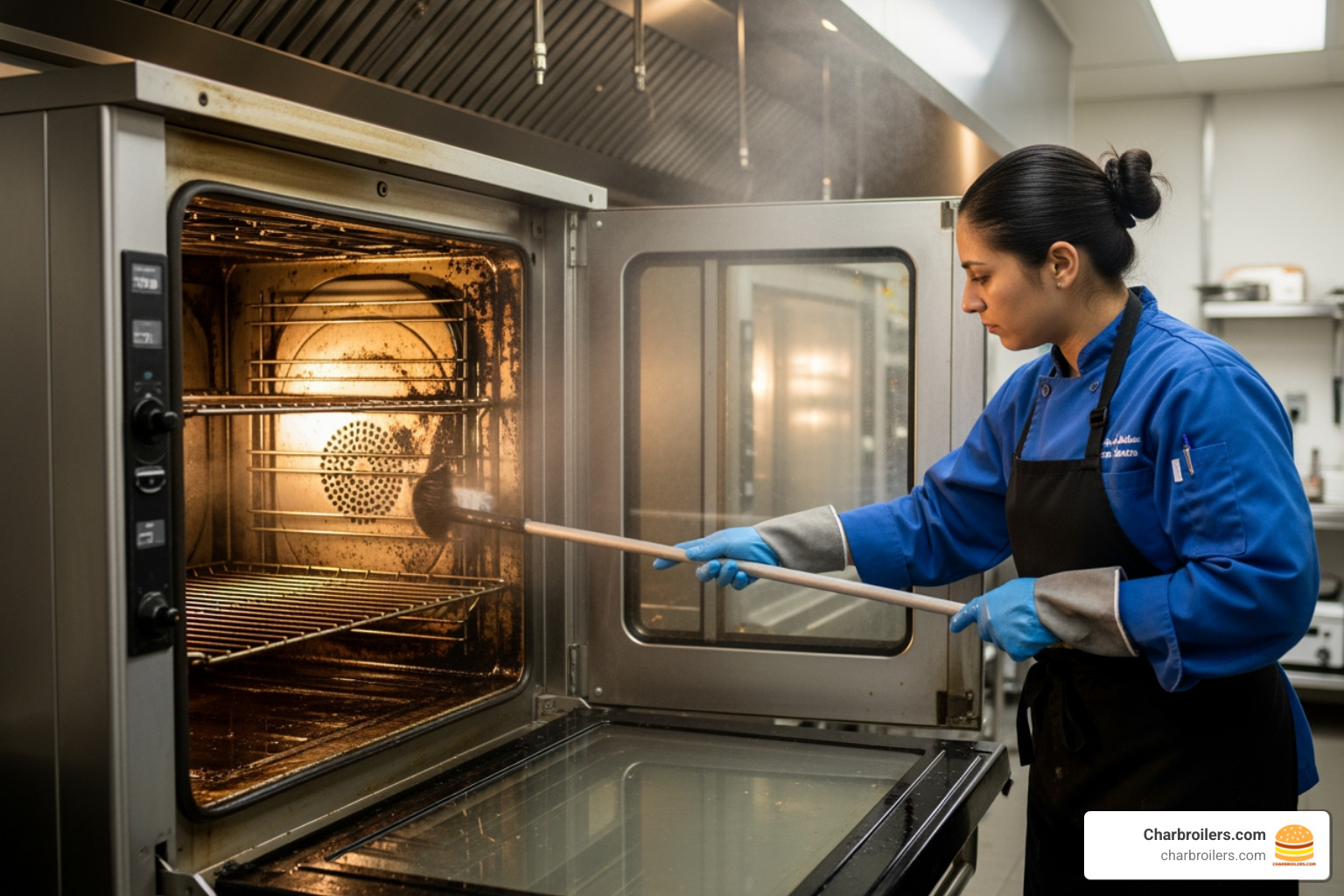
Step 1: Preparation and Safety
- Cool the oven: Ensure the oven is completely cool to the touch before cleaning.
- Turn off power: Unplug the oven or flip the circuit breaker to prevent accidents.
- Ventilate: Open windows and turn on your kitchen's exhaust fans.
- Gather supplies: You'll need heavy-duty rubber gloves, safety goggles, non-abrasive sponges or cloths, a plastic scraper, spray bottles, baking soda, and white vinegar.
Step 2: Manual Cleaning (The Safe Way)
This method is ideal for light to moderate soil and everyday spills.
- Remove and soak racks: Take out all oven racks and supports. Soak them in a sink with hot, soapy water and a gentle degreaser for several hours or overnight. Scrub, rinse, and dry them completely. Racks can handle more aggressive scrubbing than the oven interior.
- Clear loose debris: Use a brush or vacuum to remove loose crumbs from the oven floor.
- Apply baking soda paste: Mix a thick paste of baking soda and water. Wearing gloves, spread the paste over all soiled interior surfaces, avoiding heating elements and the fan.
- Let it sit: Allow the paste to sit for at least a few hours, or preferably overnight. The baking soda will break down the grease.
- Wipe away grime: Use a damp, non-abrasive sponge to wipe away the paste and softened grime.
- Use vinegar for tough spots: For any remaining residue, lightly spray with white vinegar. The fizzing reaction will help lift the grime. Wipe clean with a fresh cloth.
- Final rinse: Wipe the interior with a clean, damp cloth until all residue is gone. Dry thoroughly.
Step 3: Using the Self-Clean Cycle Correctly
Reserve the self-clean cycle for heavy, carbonized soil that manual cleaning can't handle.
- Prepare the oven: Remove everything from the oven interior—racks, supports, and any accessories. Running the cycle with racks inside can permanently discolor them.
- Wipe up large spills: Use a damp cloth to remove any large food particles to reduce smoke and odors.
- Ventilate and ensure safety: The oven will reach extreme temperatures (over 800°F) and the door will lock. Turn your range hood to its highest setting and open windows. Keep staff clear of the area.
- Let it cool: After the cycle finishes, allow the oven to cool down completely. This can take several hours, and the door will open up automatically when it's safe.
- Wipe out the ash: Once cool, use a damp cloth to wipe out the fine, powdery ash residue. No scrubbing is needed.
For more on the technology, you can learn about how the self-cleaning function works.
Frequently Asked Questions about Cleaning Self-Cleaning Ovens
Let's clear up some common questions about what is a safe commercial cleaner for self-cleaning convection oven models.
Can I ever use a standard commercial oven cleaner on my self-cleaning oven?
No. We can't stress this enough. Chemical oven cleaners will damage the specialized porous enamel liner, making the self-clean cycle ineffective. As experts note, these chemicals can be harmful to your staff. This damage will also likely void your oven's warranty, leaving you responsible for costly repairs. Stick to the methods approved by your oven's manufacturer.
What is a safe commercial cleaner for a self-cleaning convection oven's racks?
Oven racks are typically made of chrome-plated steel and are not coated with the same delicate enamel as the oven's interior. This means they can be cleaned more aggressively, but they must be removed from the oven first.
You can use stronger commercial degreasing solutions on racks. Soaking them in a large basin with hot water and a heavy-duty degreaser is highly effective. After soaking, use a stiff brush or scouring pad to scrub away residue, then rinse and dry them thoroughly before returning them to the oven. Always check your manufacturer's guide for specific recommendations.
How often should I clean my commercial convection oven?
The ideal frequency depends on your usage.
- Daily: Perform a quick wipe-down of the interior and door with a damp cloth and mild dish soap to clean fresh spills.
- Weekly: For moderate use, a light manual clean using the baking soda method can prevent significant buildup.
- Monthly (or as needed): For busy kitchens, run the self-clean cycle or perform a deep clean monthly. More importantly, clean it whenever you notice lingering odors, smoke during preheating, or a drop in cooking performance. For very tough jobs, you might consider a professional oven cleaning service.
Regular cleaning is a small time investment that protects your equipment and ensures food quality.
Conclusion: Protect Your Investment with Smart Cleaning
Understanding what is a safe commercial cleaner for self-cleaning convection oven equipment can save you thousands of dollars and prevent unnecessary downtime.
The safest "cleaner" often isn't a commercial product. It's the simple baking soda paste in your pantry, the built-in steam or pyrolytic cycle, or the specific detergent your manufacturer requires for an automated system.
The main takeaway is to always prioritize your oven manufacturer's instructions over any third-party cleaning product's claims. They know what works and, more importantly, what causes damage.
Proper cleaning does more than remove grime. It:
- Extends the longevity of your equipment.
- Maintains energy efficiency, lowering utility bills.
- Ensures food safety by preventing cross-contamination.
- Guarantees better tasting food by eliminating odors.
At Charbroilers.com, we're your partner in building and maintaining a high-quality commercial kitchen. We know proper maintenance turns a good investment into a great one. Your oven works hard for you; return the favor with smart, safe cleaning practices.
Looking to expand your kitchen's capabilities? Explore our complete guide to commercial charbroilers for your restaurant to round out your cooking line.
